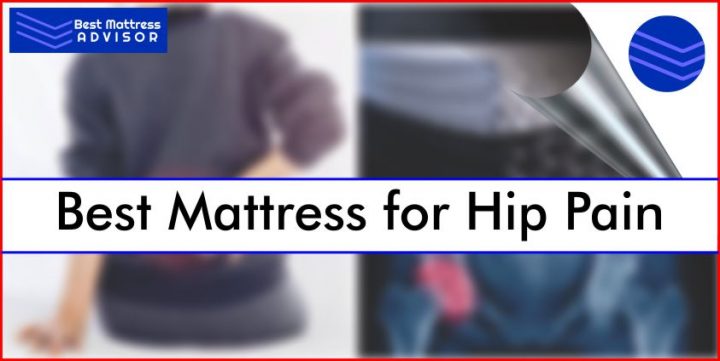
Resting sleep is essential for health and quality of life. But a decent slumber of the night may be elusive if you have orthopedic pain, especially if you are sleeping on the wrong mattress. Although some mattresses can make discomfort and rigidity worse, others can ease muscle and joint problems. If you have hip pain, the mattress option is essential for comfort and sleep enhancements.
Hip pain can be caused by many. Some of these causes can be attributed to joint wear and tear through aging and chronic use. When you use the hip, a cartilage pad prevents the bones from scratching.
This cartilage and the muscles and tendons around the hip can be affected. Different injuries may also cause hip pain. Make sure you consult your doctor if you have a condition – we are not doctors.
In comparison to your back, you want to ensure that your hip is not misaligned when you sleep. It can happen if you have a sloping or unbearable bed. If you are a side sleeper, it may be easier to have anything with zoned help.
One of the essential functions of sleep is to allow the body to relax, heal, and recover. However, to achieve these goals, we need quality sleep, which means avoiding sleep in ways that lead to pain and sorrow.
With a high-quality best mattress for hip pain, the body will get the help it needs to avoid needless pain. It can also help relax easier and improve the therapeutic effects of sleep with fewer disturbances; if you have hip pain or are prone to hip pain, then finding a mattress to reduce or avoid this pain as much as you can make sense.
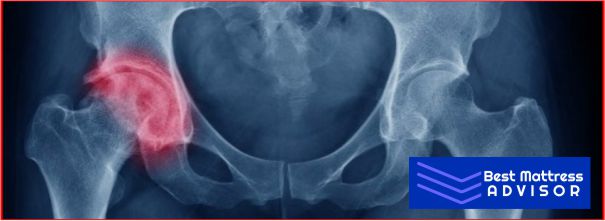
Hip bursitis is common in middle-aged and older adults, especially women. Although partly a result of age and overuse, injury or other conditions may also lead to it. You can not always prevent hip bursitis development, but you can do something to prevent and manage pain.
Even something easy, like changing your mattress, could help!
It’s completely different from the hip pain you feel in the lower back—people in that area describe pain or disease that requires medical treatment.
Alternatively, we want to talk about the many causes of hip pain and suggest the most straightforward and least painful ways to remove it. It might be so easy for many people to swap your old mattress for one that provides more comfort.
Disclaimer: We independently review all recommended products. If you buy through our links, we may earn a commission. For more details read our Affiliate Disclosure.
Causes of Hip Pain
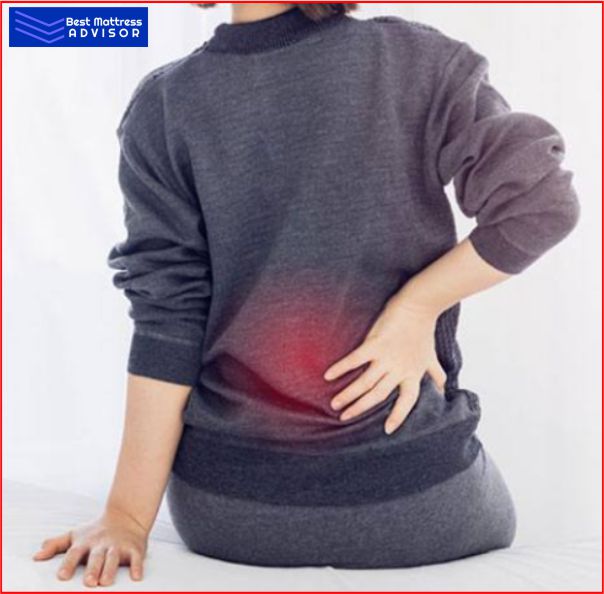
Hip pain is bad enough throughout the day, but it can seem worse in the evening when you twist and turn, trying to get comfortable in the bed. A rest position will cause even more swelling in your joints than when walkabout.
Hip pain has many common causes and symptoms. This pain can be felt right around the hip, or discomfort can be felt in other places around the leg or pelvis. Some hip pain is permanent, meaning that it lasts a long time, while others are shorter but stronger and sometimes associated with specific events.
Too much hip or lower back pressure from disease or poor posture may lead to severe tissue damage resulting in pain. Untreated and built-up pressure points may cause hips, easily broken bones, degenerative diseases, and more injury or inflammation to disturb sleep.
Sleeping Position
You’ll also want to remember your sleeping style when thinking about your mattress’s consistency and firmness. For example, the right mattress for a stomach sleeper is not always the best mattress for a side sleeper!
Bursitis
Inflammation of the bursa or bursitis, fluid inflammation of the joints such as hips, knees, shoulders, and elbows is induced. Sharp pains from the affected area also characterize this disease. The pain could be worse.
Most physicians advise changing your sleep posture to help relieve pain and sleep with hip bursitis so that you don’t place tension on the affected hip, use a wedge pillow between your knees to keep your hips aligned, and invest in a balance, some mattress (not soft or not too hard yet!).
Sciatica
Caused by an inappropriate posture, Sciatica is characterized when the sciatic nerve becomes inflamed by painful tingling in the inner hip or leg. The sciatic nerve is situated at the spine’s base and passes through the hip’s shuttering foramen to the foot. It is the largest and longest nerve of the human body.
A herniated disc, bone spur, or spinal stenosis (reducing the spine) may cause Sciatica. You can find that sleeping with Sciatica is problematic because it can be hard to find a comfortable spot. Sleeping on your back and raising your legs will help to reduce the strain on your lumbar discs. Massage therapy can also be helpful for anti-inflammatory drugs.
Sciatica is very unpleasant and can significantly decrease the quality of life of someone. This condition can be treated, but extreme cases require service.
Tendinitis
The elasticity of our tendons gets stiff with age, reducing our ability to coat the joints. Physical activity with a high impact can make the tendons sore and cause irritating joint pain.
Tendonitis can occur in many areas of the body, including elbows and brakes, but it can be hard to get better sleep if you sleep on your side when it affects your hips. Gentle workout routines, massage, physical therapy, and anti-inflammatory medications may help alleviate pain from tendonitis.
Rest, heat and ice massage, therapy, and supportive mattress may minimize tendinitis symptoms.
Arthritis
More than 100 forms of arthritis, including rheumatoid arthritis and arthritis, are present. Generally known as joint rigidity and inflammatory weakness, the condition is an immune response that destroys healthy tissue.
The elderly can easily contract the disease with weakening immune systems and children with underdeveloped immune systems.
Osteoarthritis
Osteoarthritis is closely linked to the elderly or men due to neglected injury or infection by the cartilage disintegration. This disease can cause more hip, knee, and hand pain and stiffness than other arthritis types.
Try to integrate gentle heating into your bed routine (like a warm bath) to enhance your sleep with hip arthritis; put a pillow between your knees, and upgrade to a high-quality mattress. Like swimming and yoga, low-impact workout exercises will help you control your symptoms.
Muscle Strain
Several muscles may get strained by overuse or twisting around the hip. This discomfort can be felt around the hip in some cases. Examples include hamstring strains (which are on the back of the top of your leg) or the hip flexor (on the front side of the body just below).
Hip Fractures
The hip bone fracture can be painful, but a fracture can be minor in some cases and not associated with a particular event (such as falling).
Infections
Like bones in and around the hip, bones may be involved in certain kinds of infections, such as bacterial infections can be both very dangerous and very painful when it happens.
Liberal Tear
The labrum is a cartilage ring around the outer socket of the hip joint. If the labrum is broken, it can be excruciating since it helps to cushion the joint and keep it in place.
Pinched Nerves
Several nerves may get affected, contributing to hip pain. These pains can be very sharp and radiant.
Cancer and other more extreme conditions
Bone cancer can cause hip pain than other more severe health conditions. Most of the hip pain is not cancer, but it is a potential cause in some cases.
Hip Pain and Sleep Position
Now that we have discussed the cause of hip pain, let us look at another critical element in choosing the best mattress for hip pain: sleeping. Sleep position can influence the joints and spine profoundly. Sleeping positions that cause poor spinal alignment or orthopedic stress can strain even healthy articulations. Each position has advantages and disadvantages that can affect hip sufferers’ sleep and comfort.

Side sleeping
Side sleep is the most popular of all sleep positions, and 41% of people choose it. Sleep may take place on either side of the fetus or with one or both legs down.
pros
- Sleeping on your side can prevent muscles from falling into your throat and snoring or sleeping apnea. Sleep on the left side can also decrease acid reflux by avoiding acid flow into the esophagus.
cons
- Mattress pressure and poor spinal alignment can cause shoulder, arm, and hip pain. Pressure on the jaw from sleeping against a pillow or mattress may cause jaw pain on your side.
Mattress pressure and poor spinal alignment can cause shoulder, arm, and hip pain. Pressure on the jaw from sleeping against a pillow or mattress may cause jaw pain on your side.
For side sleepers with hip pain, mattress firmness is an essential factor. A medium-soft model can help the hips crack and relieve pressure without sinking too much. Lower side-sleepers may require a medium-strength mattress, which helps to prevent excessive sinking and spine curvature.
Back sleeping
While only 14 % of people sleep on their backs, back sleep is the healthiest of all positions. Back sleeping for people with orthopedic conditions or after certain types of joint surgery is often recommended.
pros
- Return sleep aligns the spine and helps the neck and head to remain neutral. Return to sleep also distributes body weight evenly and minimizes pressure points. Sleeping on the back can reduce pressure on both sides of the hip joint, which can be useful for many people suffering from hip pain.
cons
- Back sleep can allow the tongue to fall into the throat, prevent airways, and cause apnea snoring and sleep. Back sleep can also make some people feel uncomfortable, finding it difficult to sleep in this position for long periods.
Sleeping at the back is often the preferred position for people with hip pain who may have more significant pain relief and better spinal alignment. The right color for back pain sleepers is usually a medium-sized model that coats hips and prevents spacing between the mattress and the lower back. When you are on the heavier side, a slightly firmer mattress can prevent too much sinking, making orthopedic pain worse.
Stomach sleeping
About 16 % of people sleep on their bellies. Stomach sleep is well-known for stressing the neck and spine and is generally regarded as the least healthy sleep position.
pros
- Blocking the airway by sleeping on the stomach can help prevent the tongue and reduce the risk of snoring and sleep apnea. When lying on the sides, people with hip pain may choose to sleep on their stomachs but should be aware that their position may lead to poor spinal alignment.
cons
- The dormant stomach can cause a poor alignment of the head and the back and counteract the natural spinal curve, lead to sleep and waking hours of muscle and joint pain.
In general, hip pain stomach sleepers should look for a firmer mattress that will support the spine and prevent the torso from sinking to avoid back pain. Heavier sleepers usually do best with a firm mattress to avoid poor colon alignment and strain in the neck.
Now that we talk about sleep positions and their potential effect on hip pain let’s look at the pros and cons of the most common types of colors. Most of these mattress types are common in shops, online, and as bed-in-a-box models.
Features for Choosing the Best Mattress for Hip Pain
For people with hip pain, the right mattress may make a big difference. In some words, when shopping for a model can help optimize comfort: firmness, protection, and relief from strain. These terms are relevant for buyers of mattresses, particularly those with orthopedic pain.
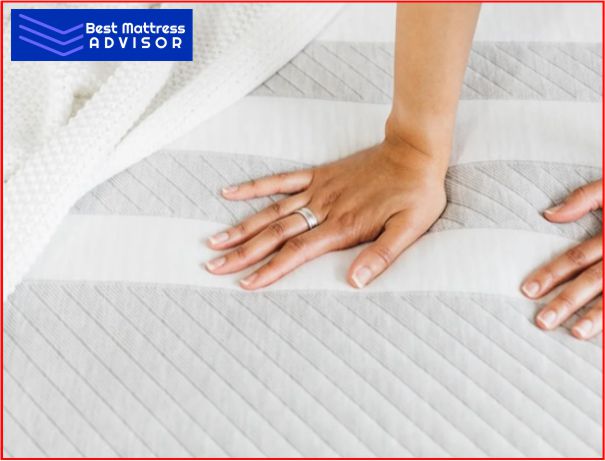
Firmness
Mattress firmness is measured on a scale of 1-10, with 1 being the softest and 10 being the most firm. 6.5 is the benchmark of the mattress industry for medium firmness. Conformity explains how a mattress feels when you lie on it. A firmer mattress gives the body more pushback and provides a better sleeping surface.
Support
Conformity and help can sound similar but identify different characteristics of the mattress. Soft as well as firm mattresses may be helpful. While firmness means the rigidity and the pushback of the mattress area, support refers to structural features that help hold the spine in a neutral position and the neck in alignment. Usually, these features include steel coils and foam support layers. A supportive mattress also avoids unnecessary sinking or “bottom-out” of bodyweight products.
Pressure Relief
Pressure relief describes a mattress’s ability to relieve discomfort in trouble areas such as the elbows, hips, and lower back. A mattress for people who sleep on their faces or experience joint or neck problems is essential. For pressure relief, contouring foam comfort layers can be significant, particularly if you have chronic hip or shoulder pain.
Durability
A mattress that feels good for certain nights or months is comfortable to find. But cheaper mattresses may break up over time and may fall in all the wrong places in a couple of years.
A shrink mattress could cause unnecessary and preventable discomfort in the hip or shoulder areas.
If you buy a mattress, you can look for something made from higher substance foam in the core. And if latex is your bed, remember that it is more durable than synthetic.
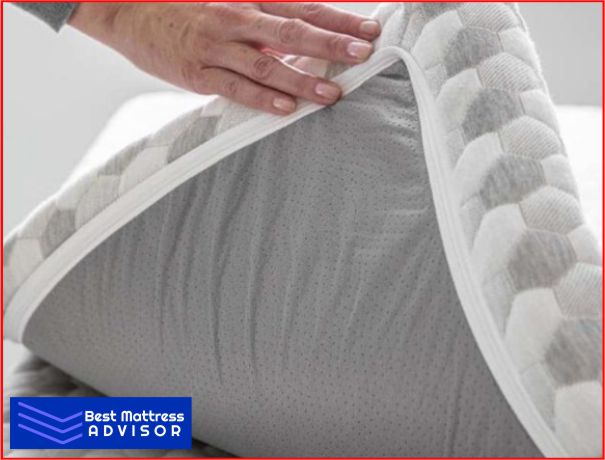
Spine Alignment
When we are in bed, our spines should be correctly aligned. But what does that mean exactly?
When you lie down, your spine will look the same as if you were looking directly at someone from your point of view. In short, it needs to look straight. Your spine should look straight if your bed is fine and you are sleeping on the right pillow.
It’s not matched whether it’s uphill or downhill. Sleep can also cause discomfort for one night, if not for weeks, for several nights.
Best Mattresses for Hip Pain Buying Guide
1. Memory Foam
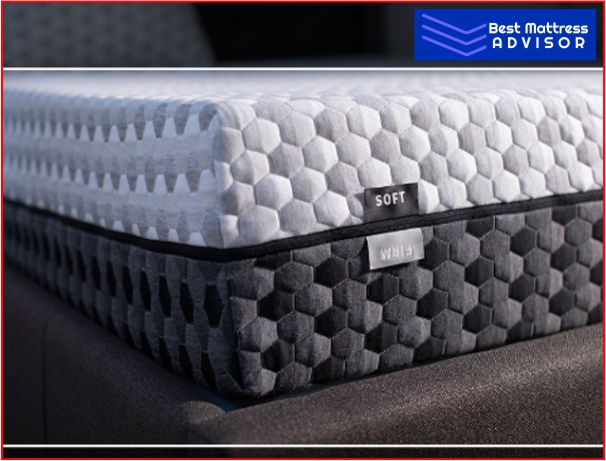
Memory foam is a type of polyurethane foam that has a pleasant feeling. It is available in a range of strength options, from extra soft to extra firm.
Pros:
- The moisture of the memory responds to pressure and body heat and is promoted to relieve pressure and conform to the body. It can be an excellent feature for hip pain people, particularly those who sleep on their sides.
- The absorbent material quality decreases movement transfers and makes it a good option for bed-sharing partners.
- The popularity and use of memory foam mattresses have become increasingly affordable.
Cons:
- Older and less expensive memorial shapes can retain body heat and ‘sleep hot’ with fewer new forms, such as gel and copper infused.
- Sloping or poor back alignment can cause fewer edges for hip pain patients who are sleeping close to the edge of the mattress.
- Memory foam mattresses may not be sufficient for individual sleepers, especially those who weigh more than 225 pounds.
2. Latex
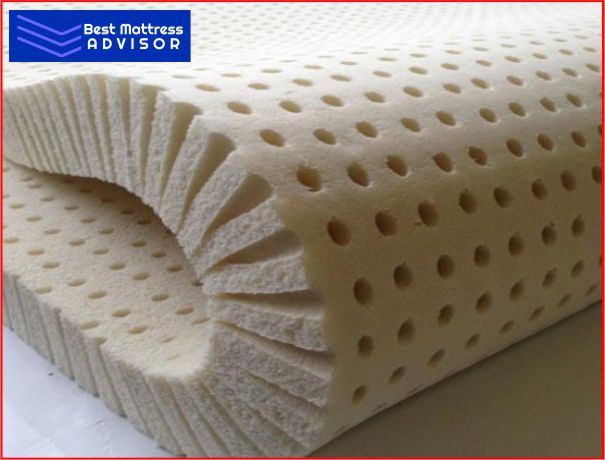
Latex foam is a natural rubber tree sap product. It feels bouncer than memory foam and has a fast pressure response.
Pros:
- The natural airy latex structure ensures better ventilation and more relaxed sleep than other memory foam.
- It is an ideal option for people with hip pain who prefer natural mattress materials.
- Hip-painted stomach sleepers may choose latex that feels more thriving and sinks less than other types of foams.
- Its comfort layers can be a good option for heavy sleepers who sink in memory or polyfoam.
Cons:
- It transfers more movement than memory foam so that bedmates can feel each other’s throwing at night.
- The material does not hug the body like memory and poly foams, and hip-pain sufferers may feel less comfortable.
- It is typically somewhat more costly than other hybrid mattresses and foams.
3. Poly Foam
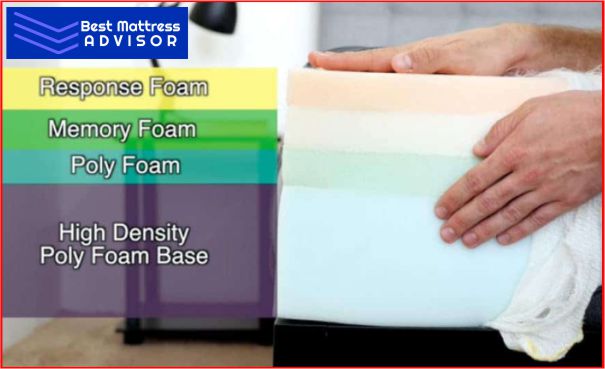
Polyfoam is a polyurethane type that lacks viscoelastic memory foam characteristics. Polyfoam has a fast pressure response and is usually used to complement memory foam or latex.
Pros:
- Polyfoam can offer hip pain sufferers pressure relief when used as a convenience layer.
- The material can feel light and airy, which may help people sleep hot with hip pain.
- Polyfoam is usually one of the cheapest materials in mattresses, especially as a comfort and support layer.
Cons:
- Low-cost poly foam types can quickly degrade, often within a few years of use.
- Polyfoam may feel less responsive and shallow than memory foam, which offers more hugs.
- When new, polyfoam can feel a strong, time-consuming smell.
4. Hybrid
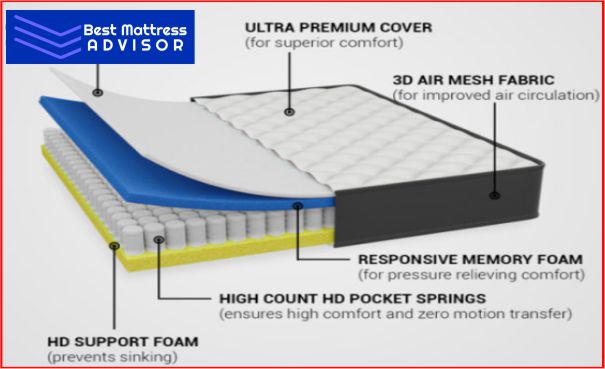
Like an in-house mattress, a hybrid uses a steel reel core for durability and structure. It provides a memory foam, polyfoam, and latex comfort layer for adequate pressure relief and support balance. Internal mattresses for hip pain patients are not typically recommended because they tend to sleep best on comfort layers that grind up the joints and muscles.
Pros:
- Hybrid mattresses typically include pocket coils that are quieter and less moving than traditional spirals.
- Its moisture comfort layers can offer hip pain relief, particularly for softer models that use memory foam.
- Hybrid mattresses may be more relaxed than all-foam and are a good option for hip-pain patients sleeping warm during the night.
Cons:
- The hybrid mattress coil structure may transfer movement, which will make it feel more bountiful and disturbing to the bedpartner.
- Hybrid mattresses can be heavier and harder to move.
- Lower-priced hybrids may not be as durable as precious materials, such as low-grade steel coils and more simple memory mold forms.
Conclusion
Hip pain can significantly affect daily life if it hampers recovery from sleep. Due to sleep with a malaligned spine, the risk of bursitis, Sciatica, tendonitis, and arthritis increased. A mattress promoting correct firmness, pressure relief, and conformity facilitates comfortable sleep without discomfort.
There is probably no more incredible frustration than sleep, particularly with hip or shoulder pain. Although this prospect of soreness is perhaps a mile long, we assume that countless natural remedies exist.
Take into account how long your mattress lasted. If it’s more than five years, you may have something different. And if you think your bed may be too hard or comfortable, try to sleep one or two nights to prove this hypothesis or reject it.
Let me know in the comments which is the Best Mattress for Hip Pain you suggest.
Images sourced from
amazon.com
